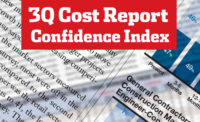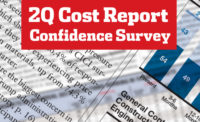The construction market currently is healthy and growing, and industry leaders are optimistic that it will continue to grow at least for another year. But while firms remain optimistic about the top line, there are growing concerns about whether the bottom line will continue to keep pace with the expanding market.
The near-term optimism can be seen in the results of the ENR Construction Industry Confidence Index survey. The CICI remained steady at 70 in the third quarter. Of the 191 executives of large construction and design firms responding to the survey, most believe market growth will continue at least until mid-2019.
But beyond that, the execs are less optimistic. For example, only 15% think the market will be in decline in 12 to 18 months, compared with 33% who say it still will be in growth mode. But in three years, 31% expect a decline, compared with 15% who believe it still will be growing.
The CICI measures executive sentiment about the current market—where it will be in the next three to six months and over a 12- to 18-month period. A rating above 50 shows a growing market.
The index is based on responses to surveys sent out between Aug. 30 and Sept. 26 to more than 6,000 U.S. firms on ENR’s candidate lists of leading general contractors, subcontractors and design firms.
|
Related Link |
CFMA: CFOs Are Upbeat
While most industry executives realize that the current bull market won’t last, most believe that the market will remain strong for another year or more. Many believe the current domestic economy will continue to generate opportunities in construction for the immediate future, despite rising materials costs and staff shortages.
The soon-to-be-released results of the latest Confindex survey from the Construction Financial Management Association, Princeton, N.J., show that CFOs are more worried about the business of construction than the market.
Each quarter, CFMA polls 200 CFOs from general and civil contractors and subs. The CFMA Confindex is based on four separate financial and market components, each rated on a scale of one to 200. A rating of 100 indicates a stable market; higher ratings show market growth is anticipated. “The overall Confindex rose from 116 in the previous quarter to 119 in the current quarter,” says Stuart Binstock, CFMA’s CEO.
The three major Confindex components measuring the near-term market rose this quarter. The “general business conditions” component was up one point, to 125; the “current conditions” component rose six points, to 130; and the “financial conditions” component was up four points, to 120. Only the “year-ahead outlook” fell, to 113 from 114, Binstock says.
There is a seasonal pattern to Confindex responses over the past few years, says Anirban Basu, CEO of economic consultant Sage Policy Group, Baltimore, and a CFMA economic adviser. He says CFMA members generally begin the year optimistic, but Confindex numbers fall when the market doesn’t meet their expectations. But this year, the current market has exceeded their early expectations, causing the Confindex numbers to continue to rise.
Rising Costs a Concern
Binstock cautions that the “year-ahead outlook” number indicates that CFOs are worried not so much about the market sagging as they are about stresses on companies’ bottom lines. Materials prices have been rising, and staff shortages are beginning to result in pressures on wages. In the survey, 85% said they were concerned about workforce shortages, up from 83% in the last quarter, says Binstock.
ENR’s CICI survey bears out the worries about materials price increases. A record 87.2% of survey respondents said that they are seeing pressure on materials and equipment costs. Steel was cited most often, by far, as a material whose prices are rising, followed by aluminum, timber and wood products, and concrete. Many survey respondents said prices are up sharply for anything covered by the recent tariffs.
The CICI survey also asked about changes in profit margins since last year. While 34.8% said their firms’ margins were higher, 13.9% said margins had fallen in the past year.
The CICI survey also asked about clients’ access to financing. A majority, 62.1%, said there has been no change in clients’ access to capital, while 23.2% said access to capital for project financing has gotten easier, and 14.7% said the credit markets were tightening. Basu says the availability of capital is not the problem. “It is the cost of borrowing that may hurt the market and the industry,” he says.
On Sept. 26, the U.S. Federal Reserve’s Federal Open Market Committee increased the federal funds rate to 2.25%, the highest it has been since April 2008, from 2%. This puts the prime interest rate at 5.25%, an increase of 1% since last summer. The Fed also hinted that further increases are in store.
“This hits contractors who have financing tied to the prime rate,” says Basu. But it also puts pressure on clients who are borrowing to finance projects.
Seeing the increasing costs of borrowing, clients may try to force industry firms to cut costs just at the time when they are facing pressure from materials and labor costs. “This is one of the reasons why the Confindex’s year-ahead outlook component dropped this quarter. CFOs see margins under siege in 2019,” Basu says.





Post a comment to this article
Report Abusive Comment